ETH Greenland Summit Experiment
This
is not an official web page of the project, but a personal overview
over some of the work that has been done in the project.
Introduction
The Greenland Summit Environmental Observatory (GEO-Summit, Summit Camp) lies in the center of the Dry Snow Zone of the Greenland Ice Sheet at 72°35' N, 34°30' W at an elevation of 3230 m a.s.l. Due to the importance
of the Dry Snow Zone for the mass balance of the entire
Greenland Ice Sheet, detailed information on the energy
balance is needed to understand the role of Greenland in a
changing global climate.
Besides the energy
balance study at this representative site, fundamental research
was conducted on longwave radiation exchange within the boundary
layer and on the spectral reflectivity of snow.
Energy
Balance
Studies
All components of the
surface energy balance were investigated during an intensive
project season which lasted from May 2001 to July 2002.
Net Radiation is determined from the individual measurements of the components of the radiation balance measured on the radiation monitoring tower (Figure 1).
The annual cycle of the radiation balance at Summit, Greenland, for 2001 is shown in Figure 2.
Temperatures measured on a chain of thermistors and thermocouples allow the calculation of the Subsurface Heat Flux. The deepest measurement level was installed at a depth of 15m. Monthly mean tautochrones are shown in Figure 3.
Sensible Heat Flux was directly measured with a eddy correlation system at 4 levels, but wind speeds and air temperatures measured at 8 levels of the 50 m meteorological tower (Figure 4) are available for calculations using the gradient method.
From the observations during the ETH Summit Project we can conclude:
Net Radiation is determined from the individual measurements of the components of the radiation balance measured on the radiation monitoring tower (Figure 1).
| Figure 1: Radiation monitoring at Summit, Greenland. |
The annual cycle of the radiation balance at Summit, Greenland, for 2001 is shown in Figure 2.
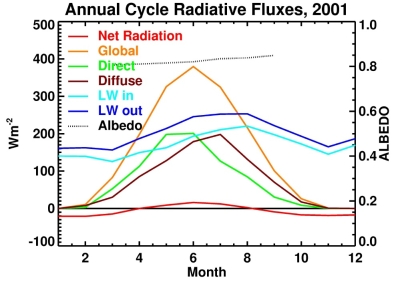 |
Figure 2: Annual cycle of radiative quantities observed at Summit, Greenland. |
Temperatures measured on a chain of thermistors and thermocouples allow the calculation of the Subsurface Heat Flux. The deepest measurement level was installed at a depth of 15m. Monthly mean tautochrones are shown in Figure 3.
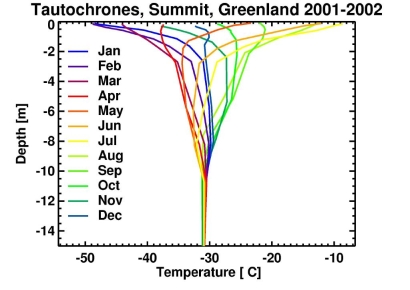 |
Figure 3: Tautochrones observed at Summit, Greenland. |
Sensible Heat Flux was directly measured with a eddy correlation system at 4 levels, but wind speeds and air temperatures measured at 8 levels of the 50 m meteorological tower (Figure 4) are available for calculations using the gradient method.
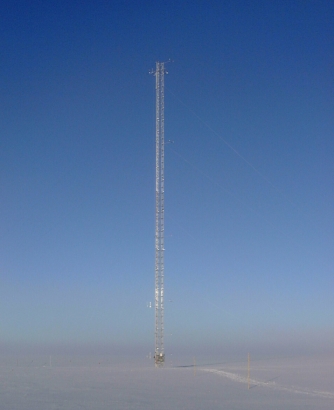 |
Figure 4: The 50 m meteorological tower at Summit, Greenland. |
Similarly, Latent
Heat Flux is directly measured or
determined from measurements at different
levels. With the use of snow lysimeters
sublimation and resublimation is
monitored regularly. A comparison of the
latent heat flux determined from the
lysimeter observation with calculations
using the profile method is shown in
Figure 5.
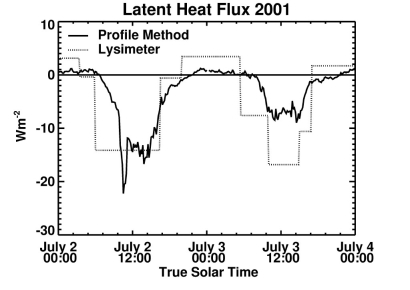 |
Figure 5: Latent Heat Flux observed with lysimeter and calculated using the profile method, Summit, Greenland. |
As an example, the monthly mean
diurnal cycles of the different
components of the energy balance are
shown in Figure 6.
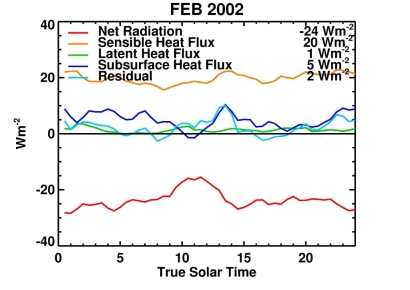 |
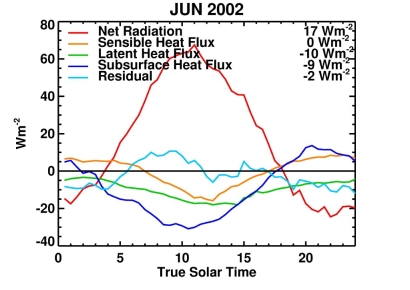 |
| Figure 6: Diurnal cycles of the components of the energy balance at Summit, Greenland, for February 2002 (left) and June 2002 (right). | |
From the observations during the ETH Summit Project we can conclude:
- During the winter months, the surface is cooled due to a negative longwave radiation balance. This cooling effect is mainly balanced by a positive sensible heat flux, and to approximately 1/3 by the subsurface heat flux. Latent heat flux is slightly positive. As the sun is below the horizon between mid November and late January, no significant diurnal variation of energy fluxes occur.
- In summer, monthly mean net radiation is positive, and net radiation is positive throughout the larger part of the day. Monthly mean sensible heat flux is close to zero, but a transport of sensible heat away from the surface can be seen around solar noon as early as in April. Negative sensible flux dominates for 10 hours in June, indicating unstable conditions close to the surface.
- Positive net radiation is balanced in equal parts by the cooling due to sublimation (loss of latent heat) and by a negative subsurface heat flux. Warming of the surface by a positive latent heat flux (resublimation) can be observed during clear-sky summer nights, but in the monthly mean diurnal cycle, latent heat flux remains directed away from the surface.
- The residuals of the seasonal energy balance are relatively large, ranging from -6 Wm-2 in fall to 4 Wm-2 in spring.
Radiative Flux Divergence
The
frequent
occurrence of strong temperature inversions makes Summit
a field laboratory for studying the stable boundary
layer (SBL). Although recognized as an important
component of the thermodynamics of the boundary layer
(Robinson, 1950; Garratt and Brost, 1981), the
divergence of the longwave radiative flux has never been
investigated experimentally across several layers within
the lower boundary layer. The few available observations
are either limited to a single layer near the ground, or
cover only a limited period of time. Especially the
shape of the radiative heating/cooling rate profile has
been under debate (Stull, 1988). It has so far only been
determined from radiative transfer calculations. The
results of such calculations, however, have been
contradictory for the near surface layers, as they are
highly sensitive to vertical resolution (Räisänen,
1996).
Observations
During the ETH Greenland Summit Experiment (June 2001 to July 2002) the profile of longwave fluxes was measured on up to 6 levels of the 50 m meteorological tower (Figure 4). A relative calibration of the pyrgeometers (Eppley Precision Infrared Radiometer) reduced the uncertainty of net flux difference measurements to ± 0.75 Wm-2 and a correction for tower‘s influence on the longwave flux measurements was applied (Hoch et al., 2007). As a first example, the longwave fluxes measured at 2 m and 50 m are shown for 21 January 2002 (Figure 7, left panel). The divergence of the net longwave flux of (0.35 Wm-3) corresponds to a longwave radiative cooling of about -30 K per day (K d-1) . The divergence of the longwave radiative fluxes is shown in the right panel of Figure 7.
Observations
During the ETH Greenland Summit Experiment (June 2001 to July 2002) the profile of longwave fluxes was measured on up to 6 levels of the 50 m meteorological tower (Figure 4). A relative calibration of the pyrgeometers (Eppley Precision Infrared Radiometer) reduced the uncertainty of net flux difference measurements to ± 0.75 Wm-2 and a correction for tower‘s influence on the longwave flux measurements was applied (Hoch et al., 2007). As a first example, the longwave fluxes measured at 2 m and 50 m are shown for 21 January 2002 (Figure 7, left panel). The divergence of the net longwave flux of (0.35 Wm-3) corresponds to a longwave radiative cooling of about -30 K per day (K d-1) . The divergence of the longwave radiative fluxes is shown in the right panel of Figure 7.
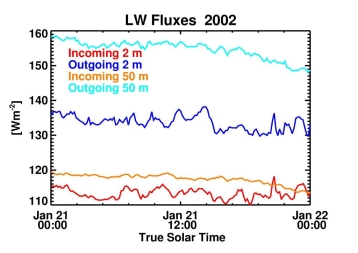 |
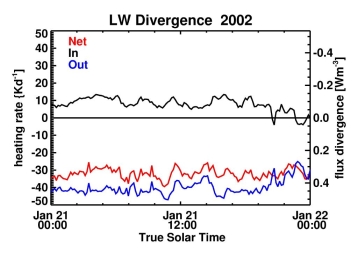 |
| Figure 7: Longwave radiative fluxes measured on 21 January , 2002, at Summit, Greenland, at 2 m and 50 m above the surface (left panel), and the corresponding radiative flux divergence (right panel). | |
In the following, the observations made
during the summer months during near clear
sky conditions are presented. These
conditions include situations with a thin
and high cirrus cloud cover.
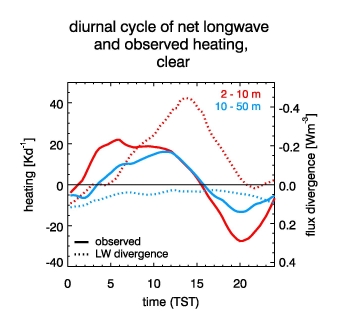 |
Figure 8: Diurnal cycle of longwave radiative heating rate and the observed temperature tendency or "full" heating rate during summer (near) clear sky days at Summit, Greenland. |
Net
longwave
radiative flux divergence leads to radiative
heating/cooling of the same order of
magnitude as the observed temperature
tendency (Figure. 8). The diurnal variation
of longwave radiative flux divergence is
shown for 4 layers and the incoming,
outgoing, and net flux components in Figures
9 a-d. Close to the surface
(0.5 -2 m), the individual
components of the longwave radiative heating
rates are very large (~ 200 Kd-1).
Similar magnitudes have previously been
observed by Eliseev et al. (2002). A
decrease in the absolute magnitude of
longwave radiative heating and cooling is
seen with height.
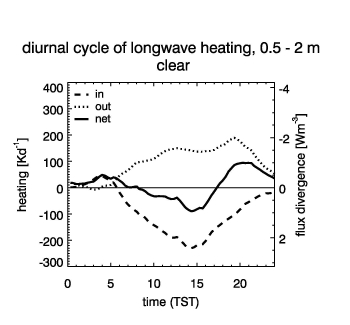 |
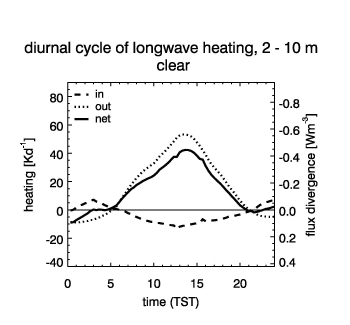 |
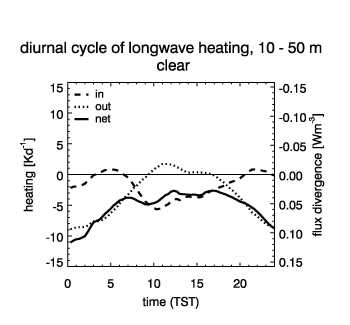 |
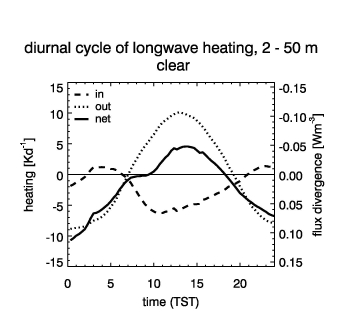 |
| Figure 7: Diurnal cycles of longwave radiative flux divergence (incoming, outgoing and net component) for 4 layers during summer near clear sky conditions at, at Summit, Greenland. | |
The divergence of the outgoing flux is
usually stronger than the divergence of the
incoming flux. The divergence of the
incoming flux usually opposes the divergence
of the outgoing flux. The importance of the
divergence of the incoming flux component
increases towards the surface.
The characteristic heating rate profile
Figure 8 shows the daytime and nighttime profiles of longwave radiative flux divergence for near clear sky conditions. Close to the surface, daytime cooling and nighttime heating is observed. During the day, a dominating incoming flux divergence, during the night a dominating convergence of the outgoing flux leads to this result. Above 2 m, the sign changes, a nighttime cooling and a daytime heating results - controlled by the divergence of the outgoing flux. Above 10 m, radiative cooling is observed throughout the entire day.
The characteristic heating rate profile
Figure 8 shows the daytime and nighttime profiles of longwave radiative flux divergence for near clear sky conditions. Close to the surface, daytime cooling and nighttime heating is observed. During the day, a dominating incoming flux divergence, during the night a dominating convergence of the outgoing flux leads to this result. Above 2 m, the sign changes, a nighttime cooling and a daytime heating results - controlled by the divergence of the outgoing flux. Above 10 m, radiative cooling is observed throughout the entire day.
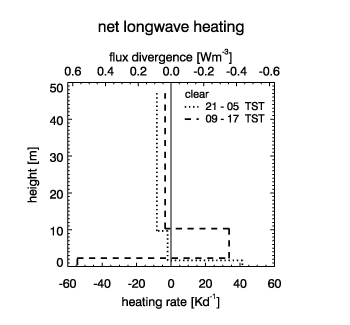 |
Figure 8: Profile of the longwave radiative heating rate for near near sky conditions during summer at Summit, Greenland. |
A
correlation is seen between the temperature
gradient within a layer and the net longwave
radiative heating rate. In the near surface
layer (0.5-2 m) an increased radiative
heating is seen with stronger gradients
(Figure 9). Above 2 m, the opposite is
seen, stronger cooling within increasingly
stable layers (Figure 10).
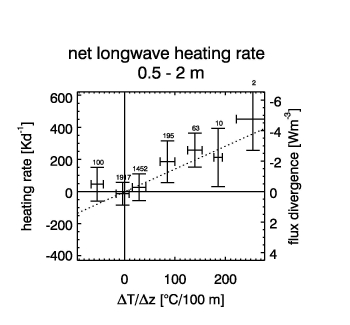 |
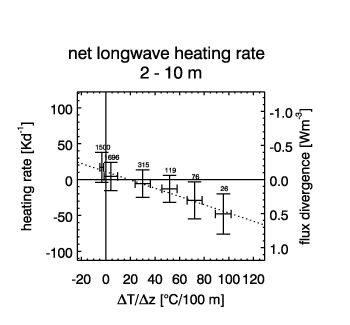 |
| Figure 9 | Figure 10 |
Radiative
heating and the fine structure of the
temperature profile
During near clear sky daytime conditions during summer, an elevated surface inversion is seen in the temperature profile (Figure 11). A similar feature has previously been observed in Antarctica (Sodemann and Foken, 2004). This inversion lies at the height were a change is observed from strong longwave radiative cooling below to strong radiative heating above (Figure 11). Radiative flux divergence is thus suggested to play an important role in the formation and maintenance of this feature. At nighttime, a characteristic feature is observed in the near surface air layers as well. A layer with a reduced stability between 0.3 m and 5 m is found. It is less stably stratified than the air layers above and below (Figure 12). Again, this pattern is suggested to reflect the variation of longwave radiative flux divergence with height. Near surface radiative heating reduces the stable stratification.
During near clear sky daytime conditions during summer, an elevated surface inversion is seen in the temperature profile (Figure 11). A similar feature has previously been observed in Antarctica (Sodemann and Foken, 2004). This inversion lies at the height were a change is observed from strong longwave radiative cooling below to strong radiative heating above (Figure 11). Radiative flux divergence is thus suggested to play an important role in the formation and maintenance of this feature. At nighttime, a characteristic feature is observed in the near surface air layers as well. A layer with a reduced stability between 0.3 m and 5 m is found. It is less stably stratified than the air layers above and below (Figure 12). Again, this pattern is suggested to reflect the variation of longwave radiative flux divergence with height. Near surface radiative heating reduces the stable stratification.
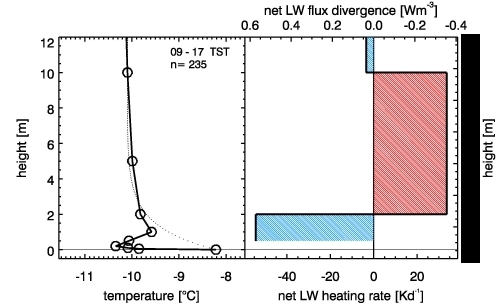 |
Figure 11 |
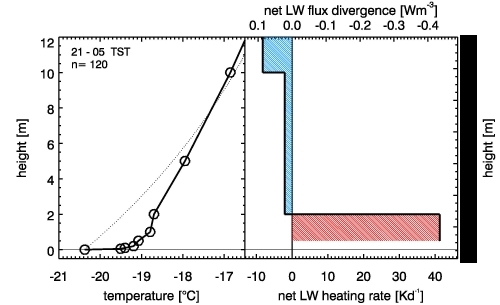 |
Figure 12 |
Summary
Longwave radiative flux divergence shows a sign change in the first few meters above the surface. Under stable nighttime (unstable daytime) conditions, a shallow layer of radiative heating (cooling) is observed at the surface. Above about 2 m, radiative cooling (heating) is found. The vertical variation of radiative flux divergence is reflected in the fine structure of the temperature profile near the surface. Nevertheless, the strong evening cooling can not be attributed to radiative flux divergence alone (Fig. 8) - contrasting the findings of Ha and Mahrt (2003).
References
Longwave radiative flux divergence shows a sign change in the first few meters above the surface. Under stable nighttime (unstable daytime) conditions, a shallow layer of radiative heating (cooling) is observed at the surface. Above about 2 m, radiative cooling (heating) is found. The vertical variation of radiative flux divergence is reflected in the fine structure of the temperature profile near the surface. Nevertheless, the strong evening cooling can not be attributed to radiative flux divergence alone (Fig. 8) - contrasting the findings of Ha and Mahrt (2003).
References
- Eliseev, A. A. et. al.,2002: Izvestiya, Atmospheric and Oceanic Physics, 38 (5), 649-657
- Garratt J. R. and R. A. Brost, 1981: J. Atmos. Sci. 38 (12), 1307-1316
- Ha, K. J. and L. Mahrt, 2003: Tellus 55A (4), 317-327
- Hoch et al. 2007: J. Appl. Meteorol., accepted
- Räisänen P.: 1996: Tellus 48A (3), 403-423
- Robinson, G.D.,1950: Q. J. Roy. Meteor. Soc. 76, 37-51
- Sodemann H. and T. Foken, 2004: Theor. Appl. Climatol. 80 (2-4), 81-89
- Stull, R. B., 1988. Kluver Academic Publishers